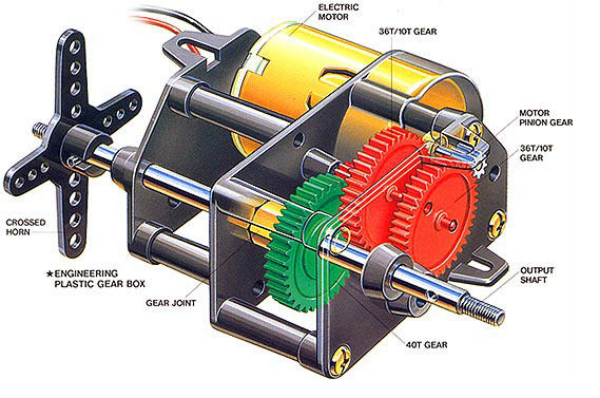Servo motors play a critical role in automation, robotics, and motion control systems. These devices provide precise rotational or linear movement, making them essential in industries like manufacturing, aerospace, automotive, and even consumer electronics. However, when choosing a servo motor, understanding its ratings is crucial to ensure optimal performance and efficiency.
Servo ratings encompass various parameters that define the capabilities and limitations of a servo motor. These include torque, voltage, current, speed, and power efficiency. Each of these ratings provides insight into how the motor will perform under different conditions and how well it will integrate into a given system.
Understanding the Importance of Servo Ratings
Servo ratings serve as benchmarks for selecting the right motor for a specific application. Without understanding these ratings, users may end up with an underpowered or overpowered motor, leading to inefficiency, performance issues, or even system failure.
Key factors that influence servo ratings include:
- Load Requirements: The weight or force the servo needs to move.
- Power Supply Compatibility: Ensuring voltage and current ratings match the power source.
- Application Type: Robotics, CNC machines, or industrial automation all require different servo ratings.
- Environmental Conditions: Factors like temperature, humidity, and exposure to dust or moisture can affect servo performance.
Understanding what do servo ratings meeeeen is essential for making informed decisions when selecting and implementing servo motors in various applications.
Torque Rating and Its Significance
Torque is one of the most critical ratings of a servo motor, as it defines the motor’s ability to produce rotational force. Measured in Newton-meters (Nm) or ounce-inches (oz-in), torque ratings indicate how much force a servo can exert on a load.
- Stall Torque: The maximum torque a servo can provide when it is not rotating.
- Operating Torque: The torque output while the servo is moving under normal conditions.
- Peak Torque: The highest torque a servo can deliver for short durations without overheating or sustaining damage.
A servo with insufficient torque may struggle to move the load, causing inefficiency and wear. On the other hand, a motor with excessive torque might lead to unnecessary power consumption and increased costs.
Voltage Ratings and Power Requirements
The voltage rating of a servo motor indicates the optimal operating voltage it requires. Common voltage ratings include:
- 4.8V – 6V: Standard for hobbyist and RC servos.
- 12V – 24V: Used in industrial automation and robotics.
- 48V and higher: Found in high-power applications requiring significant torque.
Using a voltage lower than the servo’s rating can result in insufficient power, causing slow or weak movement. Conversely, exceeding the voltage rating may lead to overheating, inefficiency, or even permanent damage.
Current Ratings and Electrical Efficiency
Current ratings determine how much electrical current a servo motor consumes during operation. This rating is essential for designing power supplies and ensuring compatibility with control systems.
- No-load Current: The current drawn when the servo operates without a load.
- Stall Current: The maximum current consumed when the motor is stalled.
- Operating Current: The average current used under normal conditions.
Excessive current draw can cause overheating and potential failure, making it essential to match a servo’s current rating with an adequate power supply.
Speed Ratings and Performance Considerations
Speed ratings indicate how fast a servo motor can rotate. Measured in revolutions per minute (RPM) or degrees per second, speed ratings vary based on the motor type and application.
- High-speed servos: Suitable for applications requiring rapid movement, such as drone gimbals and animatronics.
- Low-speed servos: Ideal for high-torque applications like robotic arms and CNC machines.
Choosing the correct speed rating ensures precise motion control and synchronization in complex systems.
Power Ratings and Energy Efficiency
Power ratings define the total energy consumption of a servo motor. Expressed in watts (W), this rating helps determine how much power is required for efficient operation.
- Low-power servos (1-10W): Used in small-scale robotics and RC applications.
- Medium-power servos (10-100W): Common in industrial automation and robotic systems.
- High-power servos (100W and above): Found in heavy-duty applications like CNC machines and conveyor systems.
Efficient power usage minimizes energy costs and heat generation, contributing to longer motor lifespan and reliability.
Temperature Ratings and Thermal Management
Temperature ratings specify the operational temperature range within which a servo can function safely. Excess heat can lead to thermal degradation, while low temperatures can impact lubrication and mechanical performance.
- Standard temperature range: -10°C to 60°C
- High-temperature servos: Designed for industrial environments with heat-resistant components.
- Low-temperature servos: Optimized for cold environments, such as aerospace applications.
Proper heat dissipation through cooling mechanisms or heat sinks is essential for maintaining optimal performance.
Duty Cycle and Operational Limits
The duty cycle defines how long a servo motor can run before requiring a cooldown period.
- Continuous Duty: Designed for non-stop operation with efficient cooling.
- Intermittent Duty: Requires periodic breaks to prevent overheating.
Selecting the right duty cycle rating ensures longevity and prevents system failures due to excessive wear.
Conclusion: Making the Right Choice
Understanding what do servo ratings meeeeen is fundamental when selecting the best motor for any application. Torque, voltage, current, speed, power, and temperature ratings all contribute to a servo’s overall performance and efficiency. Matching these ratings to your specific needs ensures optimal functionality, longevity, and reliability.
For engineers, hobbyists, and automation specialists, knowing how to interpret servo ratings helps in designing efficient and high-performance motion control systems. By carefully considering each rating, you can make informed decisions and achieve superior results in robotics, industrial automation, and beyond.
fintechzoom.com nickel: A Comprehensive Guide to Nickel Investments and Market Trends

